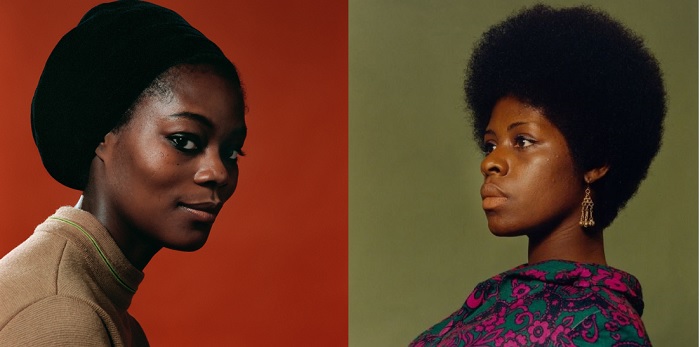
Kwame Brathwaite
American, 1938-
Untitled (Ethel Parks and Sikolo Brathwaite), 1969
archival pigment print, ed. 1/5
30 × 30 in. each
SBMA, Museum Purchase, Eric A. Skipsey Acquisition Fund
2018.30.1-2

This captivating self-portrait portrays the artist Kwame Brathwaite during the early 1960s when he, his family and colleagues were popularizing the still-influential phrase, “Black is Beautiful.” The immediacy of the image—reinforced by its square format, the artist’s hand gesture, intent gaze and strategic placement of the camera—suggests that Brathwaite is just about to speak to the viewer who is perhaps having their own portrait taken.
“We wanted Black women to take pride in their own selves, in their looks and heritage and let them be beautiful in their own right. We wanted to let them know they did not need to copy anyone else. They could wear their natural hairstyles and have Black pride.” - Kwame Brathwaite
COMMENTS
These two captivating portraits of women by Kwame Brathwaite form a trio with the self-portrait of the artist that was approved at the last Collections Committee and acquired for the SBMA by PhotoFutures at their October 19th Buying Spree. As stated in the last CC Agenda, “Kwame Brathwaite is a central figure in the emergence in the early 1960s of a distinctly African-American visual culture and identity. Brathwaite foresaw how media would be instrumental in forming public perception and opinion in the era’s consumer and entertainment realms, and used photographic imagery to change how African Americans were portrayed and seen: as stated on the artist’s website, ‘Brathwaite worked to disrupt media and produce positive images of African Americans.’ ” Brathwaite’s most resonant contribution to popular culture must be the “buoyant yet potently political statement ‘Black is Beautiful’ that has since attained iconic status.”
In contrast to Brathwaite’s black-and-white self-portrait, these two images revel in color and display Brathwaite’s deftness with photographic aesthetics and expression that lifts the works far beyond their commercial origins in fashion advertising. The body of recent Brathwaite photographic editions to which these two portraits belong takes advantage of current technologies in light, color, shadow, surface and depth to create new works of art from negatives taken in the late 1960s.
Ethel Parks, one of Brathwaite’s frequent models, is featured against a brilliant red background and turns to look at us as viewers with a rivetingly ambiguous smile. Sikolo Brathwaite, the artist’s wife and another frequent model, is seen against a green background, calmly looking to the side much like in the pose of a classic sculpture bust. As he did in his earlier self-portrait, Brathwaite placed himself and the camera close enough to his subjects to capture a nearly palpable sense of personality within each sitter, yet far enough away that each woman’s face is framed in a classically rigorous composition that is at once powerfully immediate and timelessly beautiful.
Adding these two works to the collection would fully represent Brathwaite’s extraordinary talent as a portraitist while furthering our holdings in photographs by African Americans, a collection growth area of interest. These two works are intended to be included in the upcoming SBMA exhibition, “A Brilliant Spectrum: Recent Gifts of Color Photographs to the Collection,” opening in late January, 2019.
Brathwaite’s photographs have been acquired by The Museum of Modern Art and Whitney Museum of American Art, New York; The Tang Teaching Museum and Art Gallery at Skidmore College, Saratoga Springs, NY, and the MIT List Visual Art Center, Cambridge, MA. Brathwaite's work has also been featured in the New Yorker, New York Times, New York Magazine, Vogue, and Aperture among many publications. An exhibition of Brathwaite’s work is currently on view until January 12, 2019 at the Philip Martin Gallery, Los Angeles.
Kwame Brathwaite’s art will be the subject of a major touring exhibition, “Kwame Brathwaite: Black is Beautiful,” that will open at the Skirball Cultural Center in Los Angeles in May, 2019. A monograph of the same title, produced by the Aperture Foundation, will be released in spring 2019 with essays by Deborah Willis, Professor and Chair of the Department of Photography and Imaging at Tisch School of the Arts of New York University, and Tanisha C. Ford, Associate Professor of Africana Studies and History at the University of Delaware.
- SBMA Collections Committee—December 4, 2018, pp. 14-15
SBMA CURATORIAL LABELS
In the late 1950s and early 1960s New York based artist Kwame Brathwaite was responsible for the emergence of a distinctly African-American visual culture and identity, from which arose the buoyant and potently political statement “Black is Beautiful.” Foreseeing how the era’s media would form public perception, Brathwaite used photography to change how African Americans were portrayed and seen. Brathwaite’s stated aim was “to disrupt media and produce positive images of African Americans.” Ethel Parks was a frequent model for Brathwaite’s advertising agency and media company, founded in Harlem with his brother. In ne work, Parks is posed against a brilliant red background at the AJASS Studios, and turns to us as viewers with a rivetingly ambiguous smile.
Sikolo Brathwaite, the artist’s wife and another frequent subject, is similarly portrayed against a muted green background, assuredly looking to the side in a sculpture-like pose. Brathwaite placed his camera close enough to his subjects to capture a vibrant sense of personality, yet far enough away that each woman’s face is framed in a formally rigorous composition that is immediate and timeless.
- A Brilliant Spectrum, 2019
